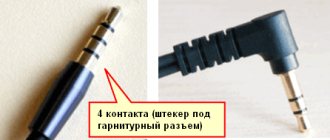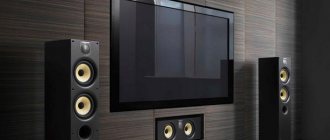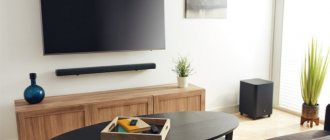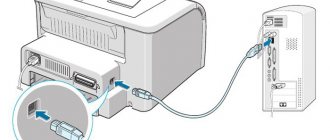How to properly connect and phase speakers? In this article we will talk about connecting speaker systems to an audio power amplifier (APA).
If you find an old Soviet amplifier and speakers in your closet or on your balcony, then do not rush to throw them away. By connecting all these rarities to the linear output of your computer, you can get good results for practically nothing.
The disadvantage of many Soviet amplifiers was poor tone control circuits. When using a computer as a signal source, you can easily compensate for this shortcoming by using a software equalizer that comes with any sound card.
How to connect speakers to a computer (passive)
- Let's say the speakers have 2 RCA inputs (tulips), then the connection is made using a Mini jack audio cable (3.5 mm jack) to 2 RCA. Mini jack connects to the sound card (green output) if you want to use them as front speakers or as a stereo pair. Or using an audio cable 2 RCA - 2 RCA and a mini jack adapter to 2 RCA inputs.
- There are 2 terminals on the columns. In this case, a cable from any headphones with a mini Jack 3.5 mm will suit you. Cut off the speakers and carefully strip the wire. Connect the stripped ends to the terminals, and the mini Jack plug to the sound card.
- Buy an inexpensive stereo amplifier, especially if you want to use speakers from a formerly decent music center, it will be worth the cost.
PS You won’t be able to achieve a particularly loud sound using this method of connecting speakers to a computer ; the output power will be several watts, since passive speakers require an amplifier, but at least save your speakers from the fate of ending up in the trash.
For those who are puzzled by the issue of buying an inexpensive receiver, the article will be of interest: “How to connect analog speakers to any equipment?” .
Possible problems and ways to solve them
There are times when it is not possible to connect acoustic devices to a TV receiver, or the sound is reproduced of unsatisfactory quality. Then you can try to solve the problem in several ways.
- If after connecting the speakers to the TV there is no sound, you need to refer to the settings of the TV receiver in accordance with the user manual. As a rule, the sound automatically switches only to the headphone jack; in other cases, the output must be selected manually.
- If the sound is very quiet after connecting the device to the headphone jack, you need to open the sound settings and increase the volume for the signal sent to this output.
- If, after connecting the speakers via the RCA output, there is no sound, you need to double-check the connection and make sure that the cable on the television panel is connected to the Audio Out connectors, and not to the Audio In.
- If the audio system is connected using HDMI ARC technology, but there is no sound, you need to make sure that this function is supported by the devices, the wire is connected to the connectors with the corresponding label, and the audio output to the speaker system is set in the TV settings.
So, if the television panel has a quiet sound, this problem can be easily corrected by connecting additional acoustics to it. These can be active or passive speakers, a multimedia or stereo system, or a home theater. To make the connection without errors, it is recommended to refer to the instructions for the TV, find out which outputs can be used for this, then make sure that there are similar inputs on the speakers. If necessary, devices can be connected using adapters.
How to connect 5.1 speakers to a computer (active acoustics)
Connecting an active speaker system for a PC is a fairly simple task, so I won’t go into this topic, but many people still have questions.
You need to figure out how many outputs or sockets your computer’s sound card has. As a rule, modern built-in sound cards allow you to use 7.1 acoustics (marked with colored sockets on the motherboard).
Green output - front (front) speakers
Orange output - center channel and subwoofer
Black output - rear (rear) speakers
Gray output - side speakers (surround speakers)
Blue - line input (electric-acoustic guitar, player, etc.)
Pink - microphone.
Depending on this, you will be able to connect the speakers to your computer. If you decide to connect 5.1 speakers, then several sockets will be used (green, orange, black). Connect the cable with the green plug to the audio output connector (green) on the rear panel of the system unit, etc. Connect the cables to the appropriate connectors (refer to the colors) on the sound card control module; when you connect the cable to the sound card, the program will show which type of speaker serves a specific socket. As a result, all 3 above-mentioned connectors on the module must be used. The speakers and subwoofer are connected with an RCA - RCA cable (tulip - tulip), one end of the cable into the subwoofer (since it most often contains an amplifier), and the other end to the corresponding speaker. On the subwoofer, each RCA output is labeled according to the type of speaker, so you can't go wrong.
Set up your computer by selecting 6-channel mode in the sound card driver application and in the Windows Sound Control Panel. If you have a 7.1 speaker system, then you will have to additionally use the gray connector on the motherboard for the side speakers. As a last resort, use the instructions for the motherboard, especially when connecting the headphone and microphone jacks on the front panel of the system unit of your PC.
Connecting Bluetooth speakers
If you don’t want to limit your movements to speaker wires, choose Bluetooth devices. They work not only with laptops and PCs, but also with phones, so purchasing them becomes a very profitable investment.
Bluetooth speakers are not very powerful, but connecting them is quite simple:
- Turn on the speakers yourself. The LED indicator should light up.
- Turn on Bluetooth on your laptop or PC (if there is no built-in adapter, you can purchase a detachable one).
- Start searching for new devices.
- Find the name of your speakers and make a connection between the devices. Some models require you to enter a password to connect.
- If the connection is successful, the indicator will blink or change color.
- Turn on the music and enjoy the sound.
Today, computers are used in many aspects of our daily lives. Each person has his own priorities when using a computer. But even those who use a computer to print documents are not averse to listening to music from CDs or from the Internet, what can we say about those who play games, watch movies and, even more so, listen to music. In order to enjoy the sound, you need the correct sound settings on your computer.
Yuri Alisievich, Trade portal Shop.by
Connecting speakers to a computer via S/PDIF (digital output)
When connecting 5.1 speakers via SPDIF, you will need an SPDIF cable (optical or coaxial).
The inputs and outputs of coaxial SPDIF are made on RCA type connectors. The digital signal is transmitted via a regular cable with appropriate connectors. In coaxial SPDIF, data is transmitted in the form of electrical pulses over ordinary wires, which are subject to all kinds of interference. In the receiving device, all these noises are filtered out, but the possibility of losing some data is still present.
Optical SPDIF uses an optical cable to transmit data. Its inputs and outputs are made on Toslink type connectors, which are closed with plugs, by which it is very easy to recognize this type of interface. Also in Creative and other sound cards there is an optical interface that uses a mini Toslink cable. An optical cable does not respond to magnetic fields at all, since data is transmitted in the form of light pulses. Therefore, it is believed that the optical digital data transmission interface is much better protected from external influences than the coaxial one. Satellite receivers use the optical type of the SPDIF interface.
The type of connection will depend on what type of interface for connecting external signal sources is available on the amplifier housing of your speaker system. You simply connect the cable to the digital output of your motherboard and connect it to the corresponding digital input connector on the speaker system (amplifier or subwoofer speaker system with built-in amplifier). It is necessary to change the signal output port in the audio card interface from analog to digital (unless, of course, the driver itself determines the connection to the digital output). The connection diagram for the speakers itself remains the same as described above. Games output sound directly without various compressions, so you still won’t be able to get more stereo sound from the game via S/PDIF. To correct this drawback, you must have a sound card that supports Dolby Digital Live or DTS Connect. These technologies allow multi-channel audio from a 5.1 or 7.1 game to be encoded on the fly into Dolby Digital or DTS and transmitted directly via S/PDIF. In practice, when one of these technologies is enabled, all audio played on the analog outputs will be re-encoded and sent to digital S/PDIF , however, often in order for the sound to be played on the analog output, you will have to set the analog outputs of the sound card as the default device in the Windows sound settings panel, and for many applications simply select analog outputs manually. For example, in normal mode, in the sound settings panel in Windows, selected S/PDIF as default device. The music player also lists S/PDIF. Now, to get 5.1 sound from any source you should:
- select one of the 5.1 audio encoding technologies Dolby Digital Live or DTS Connect in the sound card settings;
- in the Windows sound settings panel, select the analog outputs of the sound card as the main device;
Connecting speakers
Home / Information / Connecting speaker systems
Information / Connecting speakers
In professional work with sound, it is very important to understand the basic principles of switching different types of equipment; this makes it easier and faster to achieve high-quality sound and extend the life of the equipment.
Considering acoustic systems in this light, three types can be distinguished: active, passive and broadcast acoustic systems. Each type has its own characteristics, which we will consider in this article.
So, we assume that you have chosen a speaker system and bought it. After unpacking the equipment, the first question that arises is the connection.
Active acoustics. The main difference between active and passive acoustics is the presence of an amplifier built into its housing. This means that the power of the sound signal supplied to the active acoustic system (hereinafter referred to as speakers) is significantly less than to the passive one. Therefore, these speakers use their own cables and connectors designed for lower current and voltage.
Levels. Although line signal levels are standardized, inconsistencies between devices can still occur. Because in fact, in audio technology, not one standard is used, but several. The most popular line levels for audio equipment are +4 dB (1.23 V), -10 dB (0.25 V) and -10 dBV (0.32 V). As a result of a mismatch between the levels of the output device (for example, a mixer) and the input device (for example, an active speaker), the signal may be distorted or receive a large level of noise. In this regard, on devices we can often see switches for the nominal output and input levels. If there is no such switch and there is no output level regulator, then you will have to use an additional matching device.
Balance and imbalance. For high-quality signal transmission, the cable suitable for the active speaker must be shielded. It is also important to understand that the connection can be balanced or unbalanced. An unbalanced connection (unbalanced) is a connection using a single-core shielded wire. A balanced connection (symmetrical) is a connection using two shielded wires. One of the wires transmits an unchanged signal (+), and the second transmits a signal in antiphase (-). Such signal transmission allows the use of devices that, based on signal subtraction, help to effectively combat interference and interference. In practice, an unbalanced connection is more often used as jumper wires between equipment, that is, when the source and receiver are located nearby. A balanced connection is recommended for use at a distance of more than 20 meters and allows high-quality signal transmission over 200 meters. The signal transmission methods in the connected devices must be consistent; the balanced input must be connected to the balanced output. Otherwise, adapters or devices for matching the signal transmission method are used.
Hi-z. The Hi-Z input is a high impedance input that provides an impedance-matched connection between the speaker system and the guitar's pickups. That is, it is an unbalanced input for acoustic guitar, lead and bass guitar. It is also called instrument input.
Use of optional patch adapters should be done with caution. It is necessary to take into account all the above-mentioned characteristics, they must match: the input and output must have the same nominal signal level (+4 dB, -10 dB, etc.), transmission method (balance/unbalance) and impedance (input and output impedance).
Connectors. Popular powered speaker connections include XLR, RCA, and TRS.
The most popular connector in speaker systems is XLR.
Known for its high reliability. Coming into sound from aviation, the XLR connector, or as it is also called “Canon”, has successfully taken root in most professional audio equipment. The three-pin type of connector is most familiar to us, although they come in four, five, and sometimes more-pin types. Almost always, the contacts on the connector are labeled: 1 – body and/or ground, 2 – plus signal (+), 3 – minus signal (-). It can be wired for both an unbalanced connection (pins 1 and 2 are used) and a balanced connection (pins 1, 2, 3). The connector uses a latch mechanism that locks the position.
TRS and TS connectors. The “Jack” connector comes in three-pin TRS and two-pin TS.
The abbreviation stands for contact designations: 1 – Sleeve (sleeve) ground and/or body, 2 – Tip (tip) signal plus (+), 3 – Ring (ring) signal minus (-). It is clear that the TS plug can only transmit an unbalanced signal. TRS can be wired for both balance and unbalance. The size of the connector can be quarter-inch (TRS1/4”) and 1/8-inch (TRS1/8”, 3.5 mm), also called a minijack.
A connector that is often used in both professional and household equipment is the RCA connector.
People call it "tulip". It is not the most correct connection of devices from an engineering point of view. This is because at the moment of connection the signal is connected as the first contact, and not the ground contact as it should be. However, thanks to its shape and low cost, it firmly occupies its position among the popular connectors. Transmits an unbalanced signal at line level.
Almost every modern professional active speaker has a pass-through output on an XLR connector in its housing.
This output can be called differently - Link Output, Mix Out, Thru Out, Line Out, but the essence is the same - to give the signal input to the speakers for further routing. Depending on the speaker model, the output signal may be absolutely identical to the input signal or undergo some changes. For example, an already limited signal or a signal after a high-pass filter can be sent to the output. If the speaker system has a built-in mixer for several channels, then the signal from only a specific input or the total signal from all inputs can be sent to the output. Such questions can be clarified by reviewing the instructions for the speaker. This connection concept allows you to create long lines of speaker systems without running a cable from the mixer to each speaker.
The through output is also used when connecting subwoofers and satellites. It is important to “place” all the speaker systems used as a portal system on one stereo output of the mixer - Main Mix, in order to control the sound in the auditorium with one fader. Speakers performing monitor functions are connected to separate outputs of the mixer. Typically, in such a situation, the sound from the mixer from the Main Mix output is supplied to one/two subwoofers, and further from it/them, using the through output, the signal is supplied to the satellites.
It turns out that if you can connect one subwoofer with two satellites, and the sound is first supplied to it, then the subwoofer must contain two independent channels in order to send stereo to the satellites. Below in the picture we can see a diagram of a typical subwoofer panel with connectors.
Here the connections are made using balanced XLR connectors. The two channels are named A and B. Outputs: FullRange – full range of the signal, HighPass – signal after the high-pass filter. From the HighPass output, the signal from the subwoofer is sent to the satellites, from Full Range - to another subwoofer (if you have four subwoofers and two satellites).
Connection diagram (one subwoofer and two satellites):
Connection diagram (two subwoofers and two satellites):
Connection diagram (four subwoofers and two satellites, floor monitors):
Passive acoustics. When connecting passive speaker systems, you should start by checking that the power of the connected amplifier and the speakers match. This is the most important question. If the selection is incorrect, distortion (overload) of the amplifier's output signal appears, which can lead to damage to the acoustics. The output power of the amplifier should be equal to the power of the acoustics or 5 to 10 percent more. It is best to use an amplifier at 90% power (which corresponds to the maximum speaker power) than a lower power amplifier at 100% power, which does not reach the maximum speaker power ratings. If the amplifier power is insufficient, the acoustics will not “open up” completely. It is necessary to ensure that when selecting capacities, the power indicators of the same standards are compared.
Power. Manufacturers use power standards such as rated, peak, sine, DIN, RMS, AES, PMPO, Program power. And that's not all the existing power standards. Some powers are close in terms of performance, but still, do not forget that these are different powers! Such a variety of capacities can be justified by different standardization approaches in different countries. For Russia, the standards for rated and sinusoidal power are native, DIN refers to the German Institute for Standardization, RMS, AES, PMPO are Western standards. The most objective indicators are nominal (Nominal) and root mean square (RMS) power; the PMPO standard is considered the most “frivolous”, since it is difficult to truly objectively assess the power of speaker systems. There are formulas that allow you to at least roughly convert one power into the equivalent of another.
The easiest option for a buyer in selecting speakers and an amplifier is to choose devices from the same company, since large companies usually produce specific series of amplifiers in conjunction with specific speakers, repeatedly checking the reliability of such sets and optimizing their operation. A hint can be provided by brochures produced by manufacturers, which describe the optimal options for combining series of amplifiers with speakers.
Resistance. It is important to remember to match the device resistances. So for an amplifier, the technical specifications usually indicate several powers for operating resistances (for example, 2000 W for 8 Ohms / 4000 W for 4 Ohms / 6000 W for 2 Ohms). The most popular speaker impedances are 8 and 4 ohms, and not every amplifier can work with 2 ohms. These features echo the well-known concepts of serial and parallel connection of speakers. There are often situations when you need to load four speakers onto a stereo amplifier. If, for example, you connect four 4-ohm speakers to a two-channel amplifier in series, then their total resistance will be 16 ohms. We do not drop to dangerous resistance values, but we do lose power with this connection. With a parallel connection, the output power increases, however, in our case, the resistance drops to 2 Ohms. This means that the amplifier will run noticeably hotter due to the higher current. And in general, before using such a connection, you should make sure in the amplifier’s passport that it works with a 2-ohm load, otherwise there will be trouble. It is believed that at 2 ohms the amplifier's ability to control the movement of the speaker cone is reduced, which can result in a washed out bass sound.
Wire section. Everyone probably understands that although the cable resistance is low, it is there, which means it still causes a voltage drop. That is, the signal level drops, especially at high frequencies. The trick is that the resistance depends not only on the material and length of the wire, but also on its cross-sectional area. The larger the cross-section, the lower the resistance. The technical specifications for the cable must indicate the linear resistance. This means that, armed with a calculator, you can calculate, based on the length you need, what resistance the wires will have.
Phase. When connecting passive speakers, it is very important to ensure that the phases of the speakers match. This means that the cones of all speakers must move in the same direction at any given time. Usually, for convenient connection, the manufacturer marks the contacts on the speakers and the wires extending from them with marks (+) and (-). If the phasing is incorrect, the speaker cones will move in the opposite direction and thereby reduce to zero all repeating amplitudes in their signals. Since the bass component in a stereo signal is almost always the same (meaning a band within approximately 30 - 130 Hz), this part of the signal will disappear in the “anti-phase” mode. In practice, you can see a picture when two speakers standing separately produce normal sound. When the low-frequency component is turned on at the same time, it disappears. This means that one of the speakers has the plus and minus contacts connected incorrectly.
Connectors. The most popular connectors for professional amplifiers are Speakon, XLR, TS, Euroblock, and screw terminals.
XLR, TRS/TS, Euroblock – used to connect the signal input to the amplifier.
Speakon, TS, screw terminals – for connecting speaker systems to an amplifier.
TS connector. The contacts are connected as follows: the signal contact (+) is connected to the Tip contact, and the signal contact (-) is connected to the Sleeve contact.
Speakon connectors come in three styles: 8-pin, 4-pin, and 2-pin. The most popular are 4-pin - they are used to connect two-way speakers. To connect three-way ones, 8-pin ones are used. Thanks to its design, it is a very reliable connector. After connecting to the socket, the plug must be turned clockwise to secure the contacts.
Screw clamps allow you to fix wires with special metal clamps and simply stripped bare wire ends.
Routing. Most modern stereo amplifiers have Stereo, Parallel, Bridge routing modes. Typically the two channels are labeled "A" and "B". Stereo mode provides operation of two independent channels, Parallel mode provides parallel supply of a signal from input A to output A and B, while input B is not active, but each output has its own volume control, and Bridge mode will help provide maximum power per speaker, while regulator A is active.
Connection diagram (Stereo mode):
Connection diagram (Parallel mode):
Connection diagram (Bridge mode):
In the above diagrams, the speakers are connected in bridge mode using screw terminals. However, this is not the only connector on which bridge mode can be implemented. Let's take a closer look at this connection on the Speakon connector. Connector pins:
To connect the bridge mode, the wires are connected to the output contacts of channel A (pins 1+ and 2+):
Connecting speakers to an amplifier using Speakon connectors for parallel and stereo modes is the same, the only difference is in the routing itself inside the amplifier.
Stereo mode:
Parallel mode:
It can be seen from the diagrams that the stereo connection can be made either on two Speakon connectors or on one. With a double connection, contacts 1+ and 1- are used on each connector; when two speakers are connected to one connector in one plug, all four contacts 1+, 1-, 2+, 2- are used. Changing modes in the amplifier can be implemented in the form of a physical switch or in the control menu of the DSP processor.
Division into stripes. The next question is inextricably linked with the previous one. Since a professional amplifier can work equally well with both wide-range speakers and subwoofers, it is very convenient when the amplifier is equipped with a built-in crossover. This eliminates the need for additional hardware and additional switching. Since when using satellites with subwoofers it is recommended to cut off the low-frequency component, an amplifier with a built-in crossover must implement three functions - low-pass filter, high-pass filter, full range.
Let's consider options for connecting speakers to one two-channel amplifier with a crossover. Let's start with something simple.
Normal stereo mode with two full-range speakers:
Mono mode with one subwoofer and one satellite:
This mode is preferable to use when a stereo signal is not required, but increased demands are placed on the bass response.
Biamping and biwiring (Bi-Amping and Bi-Wiring). To consider the next connection you need to understand what biamping is. Biamping is a connection scheme in which each speaker of a two-way speaker system requires a separate amplifier channel. That is, such a speaker simply does not have a built-in crossover and each of the two channels supplied to the speaker must be respectively tuned to the low-frequency or mid/high-frequency band. Biwiring is a connection scheme in which wires from one amplifier channel are connected separately to the woofer and mid/tweeter speakers. Since they are still connected to one channel of the amplifier, it turns out that it must be broadband, which means that the speaker system must have a low-pass and high-pass filter installed for each speaker. That is, the same crossover, only on some kind of separate structure with filters. The benefits of this connection method are questionable, unlike biamping. Biamping can be useful in cases where, for some reason, it is impossible to place a crossover in the speakers.
Connecting a two-way speaker using a biamping scheme:
All principles of matching an amplifier and speakers are also relevant for multi-channel amplifiers. The difference is only in the number of channels and speaker systems; routing of such amplifiers also becomes more complicated. Any multi-channel amplifier can theoretically be replaced by a set of two and single channel amplifiers.
In addition to the connections of active and passive speaker systems that we have considered, we can also touch on a separate area - connecting broadcast speaker systems.
Broadcast acoustics. This equipment is fundamentally different from passive and even more so from active acoustics. The peculiarity of broadcast systems is that thanks to the use of step-down and step-up transformers in the designs of amplifiers and speakers, high-quality sound transmission over long distances is achieved. Therefore, this sound system is in demand in enterprises, offices, supermarkets, etc. Naturally, without much experience, it is very difficult to design and configure a broadcast system yourself; it is better to entrust this task to professionals.
Let's consider the basic principles of connecting broadcast speaker systems:
- There are broadcast lines with signal voltage levels of 240 V, 100 V, 70 V, 30 V and others. The AC terminals must correspond to the line voltage, that is, have the corresponding input voltage;
- when connecting speaker systems to an amplifier, remember that their total power should not exceed the power of the amplifier;
- With 100 V and 70 V amplifier modes available, speakers can be switched from a 100 V line to a 70 V line. In this case, the power of these speakers will drop by half, at the same time their number can be doubled.
- Some speakers have leads not only for high-impedance loads, but also for low-impedance loads. Usually the purpose of the contacts is written on the case; it is important not to confuse them when connecting.
- selection of AC transformer terminals - the lower the AC resistance you choose, the more power it will produce.
Ordering and delivery information Selecting speaker systems Connecting speaker systems
User Misconceptions:
Misconception No. 1 . When you are finished playing you should switch everything back for correct operation. If you keep one of the on-the-fly encoding technologies always on, you will not be able to view and listen to files with multi-channel audio, since they are already encoded and require output directly to S/PDIF.
Solution: you don’t need to switch anything, watch a movie in stereo - it’s laid out at 5.1, watch a video with a DTS or Dolby track - the sound is perfectly laid out across channels. This can be seen even on a player that can switch audio tracks, for example, The KMPlayer.
Misconception No. 2 . On-the-fly encoding of stereo sound from an mp3 file using Dolby Digital Live or DTS Connect will be several times inferior to hardware decomposition of such sound on speakers or a receiver.
Solution: If acoustics of similar quality are connected to the receiver, the difference will not be so significant. The main thing in the settings of THX Studio Pro (or a similar “improver” of the sound card) is not to forget to disable the options that create various effects: for example, it makes the voice stand out from the general sound background. Much depends on the sound card; Creative Titanium HD copes with this with a bang.
How to connect speakers to a TV (active)
- Through 2 RCA-RCA cables (tulip - tulip), one ends are in the L and R outputs, the other in the speakers, if the speakers have RCA inputs on the rear panel.
- If only a cable with a mini Jack at the end comes from the speakers, then connect it to the headphone jack on your TV.
- If you are going to connect a full music center, then using RCA-RCA cables to the L and R outputs of the TV, set the AUX mode on the music center and connect the RCA cable to the AUX input on the back panel of your center. If your TV has a sound output in the form of a mini Jack socket (black, as a rule), then you will need a mini Jack to 2 RCA adapter cable.
Choosing a place for speakers
To position the speakers, you need to choose the right place where the sound from the speakers will be most pleasant to listen to. The favorable distance that should be between two or more speakers on a computer should be at least 1.5 meters or even more. If the speakers are located close to each other, their sound will be blurred and thus the result will be poor quality sound.
It is recommended to place the speakers on a table or other devices, but not on the floor; the floor can muffle and distort their sound, this does not apply to the subwoofer. The ideal height of speakers from the floor is considered to be from 1 to 2 meters. As for the subwoofer, its best sound will be heard if it is placed on the floor, because it is known that low frequencies are well perceived on a perfectly flat and hard surface. If your subwoofer has small speakers, then it is best to install it between the left and right front speakers, about a meter in front of them.
If you decide to place the speakers not on the table near the monitor, but to hang them, for example, on the wall, remember certain rules. If the speakers are small and light in weight. Then they will not need additional insurance, but in the case of heavy speakers, the weight of which can reach 5 kg, it is worth taking care of special safety brackets in order to avoid unpleasant situations. If you made no mistakes during installation, then the speakers on your computer should sound as smooth as possible, but if one speaker sounds louder than the other, you should adjust their sound using a subwoofer or software.











